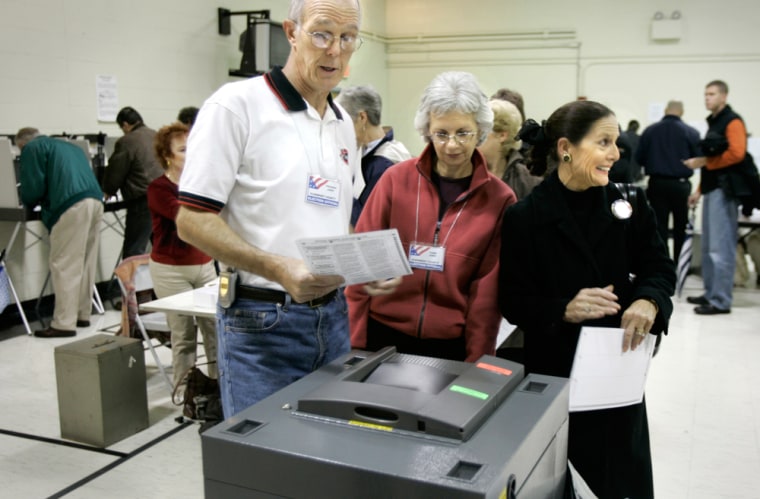At the end of the day, fears of chaos and predictions of widespread voting delays were unfounded: America’s overhauled voting system largely worked on Election Day.
There were the occasional hiccups of an all-too-human system — long lines in Denver caused by high voter turnout and a lengthy ballot, a Democratic lawsuit in Ohio over slow election machines and a long-shot Texas candidate who briefly, and incorrectly, enjoyed a big lead.
“There were some problems, in some states, but overall it looks like all the predictions of disaster turned out wrong,” said Doug Lewis, executive director of Election Center, a nonpartisan organization of state election officials.
Michael Alvarez, a political science professor at the California Institute of Technology, warned against complacency. “I don’t think we’re in the clear,” he said Wednesday. “Even 24 months from now, many of these states and counties will continue struggling with these issues.”
Paul Gronke, chairman of political science at Reed College in Oregon, said additional problems may crop up as election officials undergo recounts, possibly in Virginia and elsewhere.
More than 80 percent of the nation’s voters cast some type of electronic ballot Tuesday, the deadline for major reforms mandated by the federal Help America Vote Act. The measure was passed by Congress to prevent a rerun of the 2000 election debacle.
There were complaints of dirty election tricks, with some voters reporting intimidating phone calls, misleading sample ballots and an armed man questioning Hispanic voters outside a precinct.
Long lines
Some of the longest delays were in Denver, where hundreds waited long past the 7 p.m. voting deadline at besieged polling centers. It was a miserable end to a day fraught with new voting machine problems and the longest statewide ballot in decades.
“This is positively ridiculous,” said Jack McCroskey, who leaned on a cane while waiting to vote. “At 82, I don’t deserve to have to stand out here.”
Voter intimidation accusations prompted others to claim that some voters were bullied from getting a chance to vote.
In Virginia, where Republican George Allen battled Democrat Jim Webb in a race too close to call, the FBI was looking at intimidation complaints from voters who reported they received telephone calls telling them to stay home on Election Day, or face criminal charges.
In Arizona, three men, one of them armed, stopped and questioned Hispanic voters outside a Tucson precinct, according to voting monitors for the Mexican American Legal Defense and Educational Fund, which photographed the incidents and reported them to the FBI.
In Maryland, sample ballots suggesting Republican Gov. Robert L. Ehrlich and Senate candidate Michael Steele were Democrats were distributed by people bused in from out of state. Democrats outnumber Republicans in Maryland by nearly 2-to-1.
An Ehrlich spokeswoman said the fliers were meant to show the candidates had the support of some state Democrats. They were paid for by the campaigns of Ehrlich, Steele and the GOP. Some of the fliers include pictures of Ehrlich with Democrat Kweisi Mfume, a former NAACP president. Both Republican candidates lost.
In some states, the effort to improve the integrity of the election system got off to a shaky start thanks to balky electronic voting machines. Long lines formed in Ohio, Illinois and South Carolina and elsewhere, but voting apparently smoothed out.
U.S. District Court Judge Dan A. Polster in Ohio ordered polls stay open for an extra 90 minutes, after the Ohio Democratic Party sued Cuyahoga County because of crowded precincts.
The county, home to Cleveland, suffered 14-hour voting lines in 2004. On Tuesday, problems with ballot-reading machines caused delays of little more than an hour. It was the first time that all 88 Ohio counties used electronic voting — either touch-screens or paper ballots that were electronically scanned.
Chelsea Clinton turned away
In Texas, election officials recounted ballots after a computer glitch incorrectly showed long-shot Constitution party candidate Ron Avery ahead by a large margin in the race for a House of Representatives seat. The winner was really Democratic incumbent Henry Cuellar.
Some precincts in Illinois’ Cook County had trouble electronically transmitting results, so cartridges containing tabulated vote totals were taken to the county clerk’s office in downtown Chicago. The county board president’s race remained undecided Wednesday morning.
The problems were democratic, though, affecting the powerful and famous as well.
Chelsea Clinton was turned away at a Manhattan polling site because her name did not appear in a book of registered voters, according to her mother, Sen. Hillary Rodham Clinton. Chelsea was offered an affidavit vote, similar to provisional ballots used in other states.
In South Carolina, Gov. Mark Sanford was rebuffed because he didn’t have a voter registration card. He later returned with it.
According to an exit poll of 11,798 voters conducted for AP and television networks by Edison Media Research and Mitofsky International, about 46 percent of voters said they felt “very confident” their votes will be counted accurately. In 2004, that figure was 50 percent.
But Florida showed a significant increase — 47 percent of voters were “very confident” in their states’ ability to count votes, up from 38 percent in 2004. Though it was the site of the voting debacle of 2000, Florida has had relatively smooth elections since, including Tuesday’s midterm election.
